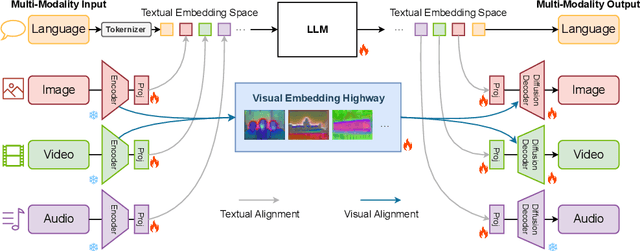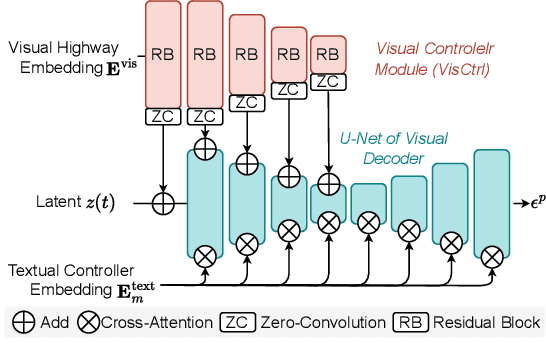Andrew Tao
Nemotron-H: A Family of Accurate and Efficient Hybrid Mamba-Transformer Models
Apr 10, 2025Abstract:As inference-time scaling becomes critical for enhanced reasoning capabilities, it is increasingly becoming important to build models that are efficient to infer. We introduce Nemotron-H, a family of 8B and 56B/47B hybrid Mamba-Transformer models designed to reduce inference cost for a given accuracy level. To achieve this goal, we replace the majority of self-attention layers in the common Transformer model architecture with Mamba layers that perform constant computation and require constant memory per generated token. We show that Nemotron-H models offer either better or on-par accuracy compared to other similarly-sized state-of-the-art open-sourced Transformer models (e.g., Qwen-2.5-7B/72B and Llama-3.1-8B/70B), while being up to 3$\times$ faster at inference. To further increase inference speed and reduce the memory required at inference time, we created Nemotron-H-47B-Base from the 56B model using a new compression via pruning and distillation technique called MiniPuzzle. Nemotron-H-47B-Base achieves similar accuracy to the 56B model, but is 20% faster to infer. In addition, we introduce an FP8-based training recipe and show that it can achieve on par results with BF16-based training. This recipe is used to train the 56B model. All Nemotron-H models will be released, with support in Hugging Face, NeMo, and Megatron-LM.
FeatSharp: Your Vision Model Features, Sharper
Feb 22, 2025Abstract:The feature maps of vision encoders are fundamental to myriad modern AI tasks, ranging from core perception algorithms (e.g. semantic segmentation, object detection, depth perception, etc.) to modern multimodal understanding in vision-language models (VLMs). Currently, in computer vision, the frontier of general purpose vision backbones are Vision Transformers (ViT), typically trained using contrastive loss (e.g. CLIP). A key problem with most off-the-shelf ViTs, particularly CLIP, is that these models are inflexibly low resolution. Most run at 224x224px, while the "high resolution" versions are around 378-448px, but still inflexible. We introduce a novel method to coherently and cheaply upsample the feature maps of low-res vision encoders while picking up on fine-grained details that would otherwise be lost due to resolution. We demonstrate the effectiveness of this approach on core perception tasks as well as within agglomerative model (RADIO) training as a way of providing richer targets for distillation.
AIDE: Agentically Improve Visual Language Model with Domain Experts
Feb 13, 2025Abstract:The enhancement of Visual Language Models (VLMs) has traditionally relied on knowledge distillation from larger, more capable models. This dependence creates a fundamental bottleneck for improving state-of-the-art systems, particularly when no superior models exist. We introduce AIDE (Agentic Improvement through Domain Experts), a novel framework that enables VLMs to autonomously enhance their capabilities by leveraging specialized domain expert models. AIDE operates through a four-stage process: (1) identifying instances for refinement, (2) engaging domain experts for targeted analysis, (3) synthesizing expert outputs with existing data, and (4) integrating enhanced instances into the training pipeline. Experiments on multiple benchmarks, including MMMU, MME, MMBench, etc., demonstrate AIDE's ability to achieve notable performance gains without relying on larger VLMs nor human supervision. Our framework provides a scalable, resource-efficient approach to continuous VLM improvement, addressing critical limitations in current methodologies, particularly valuable when larger models are unavailable to access.
Éclair -- Extracting Content and Layout with Integrated Reading Order for Documents
Feb 06, 2025



Abstract:Optical Character Recognition (OCR) technology is widely used to extract text from images of documents, facilitating efficient digitization and data retrieval. However, merely extracting text is insufficient when dealing with complex documents. Fully comprehending such documents requires an understanding of their structure -- including formatting, formulas, tables, and the reading order of multiple blocks and columns across multiple pages -- as well as semantic information for detecting elements like footnotes and image captions. This comprehensive understanding is crucial for downstream tasks such as retrieval, document question answering, and data curation for training Large Language Models (LLMs) and Vision Language Models (VLMs). To address this, we introduce \'Eclair, a general-purpose text-extraction tool specifically designed to process a wide range of document types. Given an image, \'Eclair is able to extract formatted text in reading order, along with bounding boxes and their corresponding semantic classes. To thoroughly evaluate these novel capabilities, we introduce our diverse human-annotated benchmark for document-level OCR and semantic classification. \'Eclair achieves state-of-the-art accuracy on this benchmark, outperforming other methods across key metrics. Additionally, we evaluate \'Eclair on established benchmarks, demonstrating its versatility and strength across several evaluation standards.
RADIO Amplified: Improved Baselines for Agglomerative Vision Foundation Models
Dec 10, 2024Abstract:Agglomerative models have recently emerged as a powerful approach to training vision foundation models, leveraging multi-teacher distillation from existing models such as CLIP, DINO, and SAM. This strategy enables the efficient creation of robust models, combining the strengths of individual teachers while significantly reducing computational and resource demands. In this paper, we thoroughly analyze state-of-the-art agglomerative models, identifying critical challenges including resolution mode shifts, teacher imbalance, idiosyncratic teacher artifacts, and an excessive number of output tokens. To address these issues, we propose several novel solutions: multi-resolution training, mosaic augmentation, and improved balancing of teacher loss functions. Specifically, in the context of Vision Language Models, we introduce a token compression technique to maintain high-resolution information within a fixed token count. We release our top-performing models, available in multiple scales (-B, -L, -H, and -g), alongside inference code and pretrained weights.
OMCAT: Omni Context Aware Transformer
Oct 15, 2024



Abstract:Large Language Models (LLMs) have made significant strides in text generation and comprehension, with recent advancements extending into multimodal LLMs that integrate visual and audio inputs. However, these models continue to struggle with fine-grained, cross-modal temporal understanding, particularly when correlating events across audio and video streams. We address these challenges with two key contributions: a new dataset and model, called OCTAV and OMCAT respectively. OCTAV (Omni Context and Temporal Audio Video) is a novel dataset designed to capture event transitions across audio and video. Second, OMCAT (Omni Context Aware Transformer) is a powerful model that leverages RoTE (Rotary Time Embeddings), an innovative extension of RoPE, to enhance temporal grounding and computational efficiency in time-anchored tasks. Through a robust three-stage training pipeline-feature alignment, instruction tuning, and OCTAV-specific training-OMCAT excels in cross-modal temporal understanding. Our model demonstrates state-of-the-art performance on Audio-Visual Question Answering (AVQA) tasks and the OCTAV benchmark, showcasing significant gains in temporal reasoning and cross-modal alignment, as validated through comprehensive experiments and ablation studies. Our dataset and code will be made publicly available. The link to our demo page is https://om-cat.github.io.
PHI-S: Distribution Balancing for Label-Free Multi-Teacher Distillation
Oct 02, 2024



Abstract:Various visual foundation models have distinct strengths and weaknesses, both of which can be improved through heterogeneous multi-teacher knowledge distillation without labels, termed "agglomerative models." We build upon this body of work by studying the effect of the teachers' activation statistics, particularly the impact of the loss function on the resulting student model quality. We explore a standard toolkit of statistical normalization techniques to better align the different distributions and assess their effects. Further, we examine the impact on downstream teacher-matching metrics, which motivates the use of Hadamard matrices. With these matrices, we demonstrate useful properties, showing how they can be used for isotropic standardization, where each dimension of a multivariate distribution is standardized using the same scale. We call this technique "PHI Standardization" (PHI-S) and empirically demonstrate that it produces the best student model across the suite of methods studied.
Eagle: Exploring The Design Space for Multimodal LLMs with Mixture of Encoders
Aug 28, 2024



Abstract:The ability to accurately interpret complex visual information is a crucial topic of multimodal large language models (MLLMs). Recent work indicates that enhanced visual perception significantly reduces hallucinations and improves performance on resolution-sensitive tasks, such as optical character recognition and document analysis. A number of recent MLLMs achieve this goal using a mixture of vision encoders. Despite their success, there is a lack of systematic comparisons and detailed ablation studies addressing critical aspects, such as expert selection and the integration of multiple vision experts. This study provides an extensive exploration of the design space for MLLMs using a mixture of vision encoders and resolutions. Our findings reveal several underlying principles common to various existing strategies, leading to a streamlined yet effective design approach. We discover that simply concatenating visual tokens from a set of complementary vision encoders is as effective as more complex mixing architectures or strategies. We additionally introduce Pre-Alignment to bridge the gap between vision-focused encoders and language tokens, enhancing model coherence. The resulting family of MLLMs, Eagle, surpasses other leading open-source models on major MLLM benchmarks. Models and code: https://github.com/NVlabs/Eagle
Wolf: Captioning Everything with a World Summarization Framework
Jul 26, 2024



Abstract:We propose Wolf, a WOrLd summarization Framework for accurate video captioning. Wolf is an automated captioning framework that adopts a mixture-of-experts approach, leveraging complementary strengths of Vision Language Models (VLMs). By utilizing both image and video models, our framework captures different levels of information and summarizes them efficiently. Our approach can be applied to enhance video understanding, auto-labeling, and captioning. To evaluate caption quality, we introduce CapScore, an LLM-based metric to assess the similarity and quality of generated captions compared to the ground truth captions. We further build four human-annotated datasets in three domains: autonomous driving, general scenes, and robotics, to facilitate comprehensive comparisons. We show that Wolf achieves superior captioning performance compared to state-of-the-art approaches from the research community (VILA1.5, CogAgent) and commercial solutions (Gemini-Pro-1.5, GPT-4V). For instance, in comparison with GPT-4V, Wolf improves CapScore both quality-wise by 55.6% and similarity-wise by 77.4% on challenging driving videos. Finally, we establish a benchmark for video captioning and introduce a leaderboard, aiming to accelerate advancements in video understanding, captioning, and data alignment. Leaderboard: https://wolfv0.github.io/leaderboard.html.
X-VILA: Cross-Modality Alignment for Large Language Model
May 29, 2024



Abstract:We introduce X-VILA, an omni-modality model designed to extend the capabilities of large language models (LLMs) by incorporating image, video, and audio modalities. By aligning modality-specific encoders with LLM inputs and diffusion decoders with LLM outputs, X-VILA achieves cross-modality understanding, reasoning, and generation. To facilitate this cross-modality alignment, we curate an effective interleaved any-to-any modality instruction-following dataset. Furthermore, we identify a significant problem with the current cross-modality alignment method, which results in visual information loss. To address the issue, we propose a visual alignment mechanism with a visual embedding highway module. We then introduce a resource-efficient recipe for training X-VILA, that exhibits proficiency in any-to-any modality conversation, surpassing previous approaches by large margins. X-VILA also showcases emergent properties across modalities even in the absence of similar training data. The project will be made open-source.
 Add to Chrome
Add to Chrome Add to Firefox
Add to Firefox Add to Edge
Add to Edge